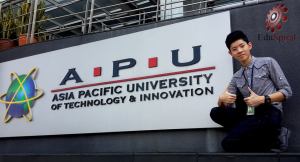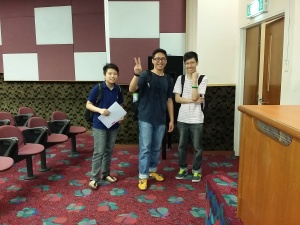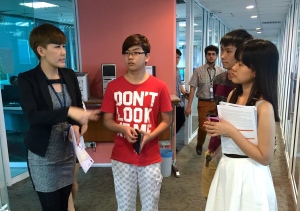All you need to know about becoming an Actuary through an Actuarial Science degree and then taking the professional papers from the Society of Actuaries (SOA) USA in Malaysia
What is an Actuary?

- After I finished my SPM, I felt confused about my further study. Because of Eduspiral, I am able to pursue my studies at Asia Pacific University. Eduspiral, was so patient to answer all my questions and even brought me to visit the university when I went to KL alone. Jeremy Lee, APU scholarship student
Actuaries are business professionals who measure and manage the financial implications of future events—pro and con, certain and uncertain, probable and improbable.
Actuaries measure and manage risk.
With a deep understanding of mathematics, actuaries forecast possibilities and develop plans to manage financial risks.
Applying a blend of math, statistics, computing and business knowledge, they serve as trusted financial and business advisors. Actuaries inform and make decisions that lead to profits, savings, stability and success.
With actuaries’ help, businesses can grow and provide greater value; leaders can make strategic decisions based on a clear understanding of risks; and people can prepare for the future with greater confidence.
What type of students should study Actuarial Science?
Students after SPM or UEC who have a passion for Maths and excel in it can consider Actuarial Science as a career in Malaysia.
Actuarial Science is a very comprehensive course in the way that it covers Mathematics, Finance, Economics, Accounting, Business Models, Computer Programming and Risk Management. As such, a high aptitude in Mathematics is highly required.
Degree students will also learn Calculus, Statistics, Probability, and Financial Mathematics. With this fundamental Mathematical knowledge graduates will be able to solve complex actuarial problems.
However, actuaries in Malaysia must also have good verbal and written communication skills especially in English, strong computer skills, time-management skills, as well as possess good judgement, imagination and clear logical thinking. They also should have a knack for problem-solving, be self-confident, and possess the ability to work under pressure.
Sharpness, creativity, practicality coupled with good business sense are also some of the key personal attributes. An actuary who has devised a brilliant solution to complex problem must be able to explain his solution to non-actuaries!
Being an actuary also requires you to master several computer programming languages such as Microsoft Excel, Microsoft Visual Basic, Microsoft Visual FoxPro, and most importantly, Prophet – an actuarial software designed to crunch a large database. If you do not enjoy learning programming languages or writing codes, actuarial science would not be the career for you.
Other than that, actuaries bring a special set of skills to their work such as:
- Specialised math knowledge
- Calculus, statistics, probability
- Keen analytical, project management, and problem solving skills
- Good business sense
- Finance, accounting, economics
- Solid communication skills (oral and written)
- Strong computer skills
- Formulating spreadsheets, statistical analysis programs, database manipulation, programming languages
Actuaries are talented professionals, with personal characteristics such as:
- Self-motivation
- Creativity
- Independence
- Ability to work with others
- Ambition
The skills developed and honed by successful actuaries include an excellent business sense with knowledge of finance, accounting, and economics; keen analytical, project management, and problem solving skills; specialized math knowledge; strong computer skills; and solid written and oral communication skills.
In addition, actuaries enjoy learning, like to solve complicated problems, enjoy writing and talking to people, can work effectively alone or as part of a team, are interested in a variety of historical, social, legislative, and political issues, and are self-motivated achievers.
As you can see, future actuaries need to be very well equipped to face the challenges of completing the professional papers and then to succeed in the competitive work environment. Students should choose universities that are reputable with an English-speaking environment so that they are forced to communicate in English and therefore improve. Remember, if you want to work for top Multi-National Insurance companies, banks and investment firms, you have to have a strong command of the English language.
Future actuaries should also be interested in research and reading a lot, so if you do not finish reading this article, you should know that you may not be suited to become an actuary.
High demand for qualified actuaries in Malaysia
According to Actuarial Society of Malaysia (ASM), there are only about 30-40 qualified actuaries in Malaysia at present. ASM predicts that given the continuous growth of the insurance industry, demand for qualified actuaries will continue to grow over the next few decades.
The president of ASM estimated that a minimum of 100 actuaries are needed to serve the Malaysian population of 24 million people. Overseas, actuaries are employed in various work areas ranging from strategic planning to weather forecasting.
Actuarial Society of Malaysia (ASM) Society Statistics As at 31 December 2014
Membership in the Actuarial Society of Malaysia (ASM) Breakdown by Class
| Class | Total |
| Fellow | 121 |
| Associate | 45 |
| Ordinary | 504 |
| Student | 38 |
| Total | 708 |
Membership in the Actuarial Society of Malaysia (ASM) by Professional Body
| Professional Body | Total |
| Society of Actuaries | 391 |
| Institute & Faculty of Actuaries | 195 |
| Institute of Actuaries of Australia | 45 |
| Casualty Actuarial Society | 39 |
| Others | 38 |
| Total | 708 |
Membership Breakdown of the Actuarial Society of Malaysia by Employment Category As at 31 December 2014
| Employment Category | Total |
| Life Insurance | 217 |
| Takaful | 122 |
| Composite Insurance | 105 |
| Consulting | 94 |
| Regulator | 39 |
| General Insurance | 38 |
| Reinsurance / Retakaful | 26 |
| Others | 14 |
| Total | 655 |
Actuaries Salary and Career Opportunities in Malaysia
Actuaries are well compensated. Experienced fellows have the potential to earn from $150,000 to $250,000 annually in the USA, and many actuaries earn more than that.
According to the 2015 Robert Walters Salary Report, the salary for an actuary in Malaysia is:
| 4 - 7 Years Experience | 8 - 12 Years Experience | 12+ Years Experience | |||
| Actuaries salary | 72 - 120k a year | 96 - 204k a year | 204k+ a year |
Compensation may vary significantly according to years of experience, industry, geographic region, and responsibilities. For
example, an actuary with a fellowship designation working as a financial manager in the banking industry could earn a higher salary than another fellow working in the health insurance industry.
The actuarial profession is perfect for individuals who enjoy challenges and problems solving. Those who develop a track-record of success will have many opportunities for growth and advancement.
Most employers of actuaries award merit increases as you gain experience and pass the actuarial examinations. Most companies also offer cash bonuses, salary increases, and promotions for each professional designation achieved.
Skills acquired by actuaries, especially the quantitative analysis of risk, are valued in the marketplace. As such, those who have the will to succeed can aspire to career advancement with an actuarial credential.
What do Actuaries work as in Malaysia?
Actuaries work in insurance and everywhere in-between.
Actuaries are at work all over the world—anticipating and solving financial, economic and other problems for companies, institutions and societies.
Actuaries are in demand in financially focused businesses including insurance, employee benefits and consulting. The field is expanding to include just about any industry or opportunity where decisions carry financial weight: banking and investments, government, energy, e-commerce and marketing. More and more, leaders want to reinforce their decisions with trusted analysis.
Actuaries measure risk and discover ways for people and organizations to stay secure, even when the risks are high. And because risk is everywhere, so are actuaries.
People generally know that actuaries work in the insurance industry but what is it that an actuary really does? If you have a life insurance policy, you’ll have to pay premiums regularly to your insurance company in exchange for the financial protection that the company is providing you. Have you ever wondered who calculates the amount of premium you have to pay?
Actuaries build and use mathematical models based on statistical data to calculate the appropriate amount of premiums to charge policyholders. This will require projections of how events will unfold in the future. In calculating the right amount of premiums, the actuary will need to project how large potential claims will be and when they will occur.
Such projections are incorporated into the models to calculate the premium required. At the same time, judgement, business acumen and experience are required to understand and logically interpret the results of the model before finally coming up with a solution to the problem. Actuarial science is a combination of science and art!
Calculation of premiums is only one of the many contributions of actuaries to insurance companies. In addition to pricing decisions, actuaries are involved in designing insurance products, formulating investment strategies, determining reserves to be set up to meet future claims and recommending distribution of profits to shareholders after taking into account the insurance company’s future obligation to policyholders.
Actuaries also estimate the amount of future claims by analysing past data or experience to assign probabilities to events such as death, sickness, disability, loss of property or even loss of business profits. Actuaries provide solutions to today’s insurance and financial problems that properly take into account the financial impact of future events. With the actuaries’ expert knowledge
in financial matters, they are often key advisors to the Board of Directors.
An actuary’s job is not just boring desk-bound number crunching. Actuaries are faced with challenges of the ever-changing economic environment in which they have to constantly update their techniques of assessment and calculation. It is an intellectual challenge to analyse current trends and predict the future as we live in a world where the unexpected (e.g. the SARS outbreak, September 11 etc.) can happen.
Due to the demand for actuarial technical skills and knowledge, there are vast career options and opportunities for an actuary. Traditionally, actuaries worked only in the insurance industry. However, with the growing acknowledgement and recognition of actuarial skills today across the various financial sectors, the potential employment opportunities of an actuary have expanded to encompass banks, investment companies, security and commodity broker firms, regulators and even lecturing in the education sector. With such demand, there is an ever-increasing need for actuaries all around the world.
In Malaysia, most actuaries are still working in the traditional life and non-life insurance industry. However, based on trends worldwide and the rapid growth of the Malaysian financial industry, it is expected that more and more actuaries will ventured into the non-traditional areas as mentioned above.
In the wide field of opportunities to manage risk, one industry employs more actuaries than any other: insurance. Within this  industry, actuaries hold significant positions:
industry, actuaries hold significant positions:
 industry, actuaries hold significant positions:
industry, actuaries hold significant positions:- In insurance companies, where actuaries develop, price and manage products across all lines of business—life, health, retirement, and general insurance (property and casualty).
- With consulting firms, where actuaries advise employers on the design and management of pension, retirement and other employee benefit programs and provide actuarial advice to insurance companies and other providers of financial services.
- Within employee benefits departments, where actuaries define, create and manage pension and retirement plans for employees.
- In government agencies, where actuaries operate retirement and insurance programs.
- For financial advisories, where actuaries provide financial planning guidance to individuals.
With actuarial work, opportunities grow and change along with the world. For instance, changes in healthcare laws have created the need for more actuaries to evaluate the effects of those laws on insurance programs and benefit plans. Additionally, catastrophic weather brings opportunity for actuaries in the general insurance field to predict, evaluate and cover the risks associated with potential storms.
Examples of actuarial work:
- Valuation -performs experience studies, cash flow testing and other tasks to set the amount of reserve and capital to be held by an insurer
- Pricing -determines product features and pricing of products
- Pension -certifies the contributions needed to adequately fund a pension plan
- Consulting -advises clients on actuarial financial risks, usually associated with employee benefits and insurance
- Reinsurance -performs traditional actuarial duties for a reinsurer that would accept risk from a direct insurance company
- General Insurance - performs roles like a valuation or pricing actuary, with a specialty in property and casualty insurance
- Health Insurance -performs actuarial duties for a health organization or insurer
- Product Line or Segment Risk Management - performs risk management functions for a specific line of business for an insurance company
Non-traditional Career Pathways for Actuaries in Malaysia
In terms of employment opportunities for actuaries, the insurance industry is number one—but not the only industry for actuaries.
Wherever there is risk—and a desire to manage it—there is opportunity for actuaries to apply analytical skills and business knowledge to solve problems. Changes in the world bring new risks; and new risks mean new challenges for actuaries. Also, as more leaders and organizations see that risk modeling and management can help them navigate volatile situations, actuarial careers are taking exciting turns.
Actuaries are finding roles in industries where actuaries have never been.
As companies seek greater control over risk, they are bringing actuarial work in-house. Enterprise Risk Managementhas become such a trusted, essential function that some organizations employ a Chief Risk Officer, a risk management-focused position at the most senior level of business leadership.
Additionally, actuaries find professional growth and personal satisfaction in fields such as:
- Financial services, such as banking, investment management and stock markets in developing economies
- Technology, e-commerce and business start-ups of all sorts
- Environmental causes, climate change and weather risk management
- Transportation, such as shipping and air travel
- Energy, such as utilities, oil and gas
- Government institutions, social programs and other groups that help shape legislation
Examples of non-traditional actuarial fields in Malaysia
- Business Analytics, where actuaries work on predictive modeling and data mining
- Enterprise Risk Management, where actuaries provide tools, techniques and perspective to manage operational risks at an enterprise or corporate level
- Senior Management, where actuaries provide broad business and management oversight for an organization’s most senior decision makers
- Investments and Fund Management, where actuaries focus on asset risks for asset managers but also contribute in areas such as hedging strategy, derivatives structuring and structured finance
- Banking and Financial Services, where actuaries help banks and financial services companies with product portfolio, capital management and risk analysis
- Environmental Finance, where actuaries apply finance techniques and practices to environmental issues
- Wealth Management and Financial Planning, where actuaries contribute skills and expertise to wealth management firms and individuals (rather than to insurance companies)
- Health and Retirement Financing, where actuaries offer advice on aspects of social insurance including funding levels and population projections
- Sales and Marketing, where actuaries help set policies, messages and compensation levels for those directly involved in marketing
- Entrepreneurial Actuaries, which represents a wide range of opportunities for actuaries who desire to set up and run their own business
Where do most actuaries work in Malaysia?
Actuaries are normally found in the insurance industry. They also work in consulting, financial institutions, banks, investment,
brokerages, or as lecturers.
The American Society of Actuaries defines actuaries as ‘professionals who provide expert advice and relevant solutions for business and societal problems that involve economic risk.’ In Malaysia, one of the places where actuaries are often found is at insurance companies. Using mathematical models based on statistical data, they are the brains behind the calculation of the amount of insurance premium that a policyholder has to pay.
With their readily transferable skills, actuaries can also be found in many other fields. Besides the hugely popular insurance field, an actuary can work in finance, marketing, manufacturing or in the development of new products.
For example, an actuary might be hired by a business to help determine where it
should invest its money based on risk and potential return analysis. Opportunities for actuaries range from the education industry to research work and even to government agencies. Because of the importance of their work, actuaries are respected throughout
the business community.
In Malaysia, most actuaries can be found in life insurance companies, financial institutions such as banks, consultancies providing advice in the fields of employee benefits, life insurance and general insurance, Bank Negara Malaysia and public universities.
The areas of work for actuaries are not limited to insurance firms only. Instead, the horizon for this line of job is very wide. Below are some of the areas of work which actuaries do:
- Life Insurance / Family Takaful
- General Insurance / General Takaful
- Reinsurance / Retakaful
- Actuarial Consulting
- Investment and Financial Services
- Employee Benefit Industry (e.g. EPF)
- Government Sector (e.g. BNM)
- Colleges and Universities
What are the career options available to actuaries?
Actuaries have historically taken on the following positions in companies:
- Chief Executive Officer (CEO)
- Chief Risk Officer (CRO)
- Chief Financial Officer (CFO)
- Appointed Actuary / Signing Actuary
- Asset/Investment Consultant
- Management Consultant
Please fill up the form for more information. If you do not give your mobile number or full name as in IC, your query will not be answered. Please make sure you give a correct email address and check your email including the SPAM or JUNK email folder within 48 hours as we will email you the information.
[contact-form subject='[EduSpiral Consultant Services - Education advise on the best universities %26amp; colleges in Malaysia%26#x002c; Hong Kong%26#x002c; Singapore and UK The top universities and colleges in Malaysia offering the best courses'][contact-field label='Full Name as in IC. (If you are the parent%26#x002c; please give the child%26#039;s name)' type='name' required='1'/][contact-field label='Email' type='email' required='1'/][contact-field label='Hand Phone Number' type='text' required='1'/][contact-field label='Qualification (SPM%26#x002c; A-Levels%26#x002c; STPM%26#x002c; UEC%26#x002c; etc)' type='text'/][contact-field label='Course of Interest/Remark' type='textarea' required='1'/][/contact-form]
The pathway to become a professional Actuary in Malaysia
The path to becoming an actuary involves going through a well-structured education plan. This involves university-level education
and post-university examinations, as well as other requirements.
Students after SPM, can go for the Foundation and then degree programs in Actuarial Science with exemptions from the professional papers. Upon completing the degree, students can then begin to take the professional exams. Students interested to take the fastest path to become an Actuary in Malaysia should go for Heriot-Watt University Malaysia's Actuarial Science degree programme which has the highest exemptions from the Institute and Faculty of Actuaries (UK).
To become an actuary through the Society of Actuaries (SOA) USA route, students can go for top reputable universities such as Asia Pacific University or UCSI University where the degree has exemptions from the VEE Professional Papers.
A normal bachelor degree takes 3 years. Thereafter, writing the professional exams through the Society of Actuaries (US) takes an average of 3-7 years (working and studying) after the degree.
Qualifying to become a professional Actuary in Malaysia
No specific degree is mandatory, but like most good jobs, graduating from
university will give one a certain edge and credibility. Most practising actuaries today have a degree in mathematics, actuarial science, statistics or computer science. Similar to accountants, graduates must also pass professional exams, before they become recognised as an actuary.
In Malaysia, to be recognised as an actuary, one will have to be a registered member with the Actuarial Society of Malaysia (ASM).
What kind of support do local and foreign companies provide?
Most, if not all local and foreign companies support their actuarial students by having actuarial development programs with the following incentives:
- Study and exam leave
- Full/partial reimbursement on costs of study material
- Salary increment and/or bonus upon passing of exams
Which actuarial professional bodies are recognized in Malaysia?
Malaysian insurance regulator, Bank Negara Malaysia and the Actuarial Society of Malaysia (ASM) recognize Fellows of the following organizations as qualified actuaries:
Currently, the ASM does not conduct any of its own exams, but aspiring actuaries in Malaysia can choose to take the exams conducted by one of the above professional bodies.
Where to study Actuarial Science degree in Malaysia?
Students can consider studying the BSc (Hons) Actuarial Science at UCSI University or obtain a Staffordshire University, UK degree locally in Malaysia at Asia Pacific University graduating with the BSc (Hons) Actuarial Studies.
The best university in Malaysia for Actuarial Science would be Heriot-Watt University Malaysia where students can get 8-paper exemptions out of 15 needed to qualify as a Fellow at the Institute and Faculty of Actuaries (FIA), UK.
What are the passing rates like?
Passing rates are generally low compared with other professions.
For the Institute, Society or Faculty professional exams, passing rates as low as 15% - 25% per subject are not uncommon.
For the Institute, Society or Faculty professional exams, passing rates as low as 15% - 25% per subject are not uncommon.
About the Society of Actuaries (SOA) - USA
The Society of Actuaries (SOA) is a professional organization for actuaries based in North America. It is a full member
organization of the International Actuarial Association.
The Society's vision is for actuaries to be recognized as the leading professionals in the modeling and management of financial risk and contingent events. The SOA has three overall goals: providing primary and continuing education for students and practicing actuaries, maintaining high professional standards for actuaries, and conducting research on actuarial trends and public policy issues.[5]
The Society's members are mainly involved in the life, health, and pension areas of the actuarial profession. There are three designations offered by the Society. The two Associate-level designations are Associate of Society of Actuaries (ASA) and Chartered Enterprise Risk Analyst (CERA), which was introduced in 2007. The highest designation is Fellow of the Society of Actuaries (FSA). As of April 1, 2011, SOA membership consisted of 8,712 Associates and 13,489 Fellows.
Requirements for membership for the SOA include the actuarial exams, a comprehensive series of competitive exams. Topics covered in the exams include mathematics, finance, insurance, economics, interest theory, life models, and actuarial science. Non-members working in the actuarial profession and taking exams are often referred to as actuarial students or candidates.
Overview of the Society of Actuaries (SOA) Examinations in Malaysia
Professional designations in the Society are earned by completing a rigorous system of examinations. It is common for actuarial
students to work full-time in the profession while studying for the exams.
The first five ("preliminary") exams consist mostly of core mathematics related to actuarial science including probability, statistics, interest theory, life contingencies, and risk models.
A series of online learning modules, called the Fundamentals of Actuarial Practice (FAP), are intended to be taken after the preliminary exams. They cover real-world topics such as insurance and professionalism with readings, case studies and projects. The preliminary exams and FAP modules comprise the majority of the education requirement for the ASA designation.
Upper-level exam topics for the FSA designation include plan design, risk classification, enterprise risk management, ratemaking and valuation. Three fellowship exams are taken in one of six specialization tracks chosen by the candidate - Finance & Enterprise Risk Management, Investments, Individual Life Insurance & Annuities, Retirement Benefits, Group & Health Insurance, or General Insurance.
Candidates completing the Finance & Enterprise Risk Management track will also earn the CERA designation. Candidates in any of the other five tracks have the option of replacing their track-specific Enterprise Risk Management exam with a more generalized ERM exam in order to obtain the CERA designation in addition to FSA
Meaning of FSA and ASA Designations
The Society of Actuaries Bylaws states that a member may use the designation "Fellow of the Society of Actuaries" or "Associate
of the Society of Actuaries," as applicable, or the corresponding initials. Since these designations will be viewed by the public as conveying a certain professional standing, this brief explanation of their meaning is intended to be helpful to our members and to the public.
The Society of Actuaries, as described in our Mission and Vision Statement, is an education, research, and professional membership organization. Achieving Fellowship or Associateship status is based primarily on completing specified educational requirements, with no requirement related to a certain number of years of practical actuarial experience. The FSA and ASA designations and CERA credential signify completion of the following educational achievements:
- Chartered Enterprise Risk Analyst: A Chartered Enterprise Risk Analyst (CERA) of the Society of Actuaries has demonstrated knowledge in the identification, measurement and management of risk within risk–bearing enterprises. The CERA has also completed a professionalism course covering the professional code of conduct and the importance of adherence to recognized standards of practice. CERAs who have the Application for Admission as an Associate approved by the SOA Board of Directors will be granted membership as an Associate.
- Associate: An Associate of the Society of Actuaries has demonstrated knowledge of the fundamental concepts and techniques for modeling and managing risk. The Associate has also learned the basic methods of applying those concepts and techniques to common problems involving uncertain future events, especially those with financial implications. The Associate has also completed a professionalism course covering the professional code of conduct and the importance of adherence to recognized standards of practice. Associates who have been members of the SOA for five or more years may also vote in Society of Actuaries elections.
- Fellow: Has demonstrated a knowledge of the business environments within which financial decisions concerningpensions, life insurance, health insurance, general insurance and investments are made including the application of mathematical concepts and other techniques to the various areas of actuarial practice. The Fellow has further demonstrated an in–depth knowledge of the application of appropriate techniques to a specific area of actuarial practice. Fellows may vote in Society of Actuaries elections.

- "I attended EduSpiral's Education Fair at KInta Riverfront after my SPM exam in December and obtained great information there. Although Asia Pacific University is famous for IT but I found out that they have a solid accounting programme and I can get a UK degree. I got a scholarship as well from APU."
Julian Hum, from SMK St. Michael Institution, Ipoh studying Business at Asia Pacific University.
When Associate status is achieved, the individual becomes a member of the Society of Actuaries, is able to attend meetings, join in discussions, participate on Committees, join Sections, and is subject to the code of conduct for the profession. All Fellows and five-year Associates may vote in Society of Actuaries elections.
While these educational accomplishments are a vital part of an actuary's progress, they must be combined with appropriate training and practical experience in order for an actuary to be qualified to practice and to give advice on a specific issue.
It is important to note that the Society of Actuaries' professional designations and credentials, of themselves, recognize educational accomplishment only.
In most cases, by the time an individual reaches the Fellowship level, considerable practical experience has been acquired.
The combination of educational achievement, practical experience, and formal qualification (e.g., Enrolled Actuary; Fellow, Canadian Institute of Actuaries; Member, American Academy of Actuaries) permits the actuary to practice within his or her area of expertise.
How to become an Associate of the Society of Actuaries (SOA) in Malaysia
An Associate of the Society of Actuaries has demonstrated knowledge of the fundamental concepts and techniques for modeling

- Asia Pacific University students have access to state-of-the-art computer facilities that include the latest PCs and workstations with Internet connection, operating systems, software suites and commercial programming software in multiple IT labs built for project work, multimedia production, software and internet programming.
and managing risk. The Associate has also learned the basic methods of applying those concepts and techniques to common problems involving uncertain future events, especially those with financial implications.
The Associate has also completed a professionalism course covering the professional code of conduct and the importance of adherence to recognized standards of practice. Associates who have been members of the SOA for five or more years may also vote in Society of Actuaries elections.
Candidates earn the ASA designation by completing the following requirements:
- All candidates must complete Exams P, FM, MLC, MFE and C, collectively known as the preliminary exam requirements.
- All candidates shall satisfy Validation by Educational Experience (VEE) for three subjects: economics, corporate finance and applied statistics.
- All candidates must complete the Fundamentals of Actuarial Practice (FAP) Modules 1–8 and all related assessments.
- All candidates must also complete the Associateship Professionalism Course (APC). Candidates must also have an approved Application for Admission as an Associate on file, as described above.
The first step is to become an Associate of the Society of Actuaries
| Exam P–Probability | Exam FM–Financial Mathematics | Exam MFE–Models for Financial Economics | Exam MLC–Models for Life Contingencies | Exam C–Construction and Evaluation of Actuarial Models |
| VEE* Economics | VEE* Corporate Finance | VEE* Applied Statistics | Fundamentals of Actuarial Practice (FAP) e–Learning Course | Associateship Professionalism Course (APC) |
* Validation by Educational Experience–Candidate must show that subject has been sufficiently covered by university or other coursework.
1. Preliminary Education Component
Consists of five papers:
Students will take Exam P and Exam FM first, and then only go for Exams MLC, MFE and C.
- Exam P Probability
- Exam P is a three–hour multiple–choice examination and is offered via computer–based testing (CBT). The syllabus for Exam P develops the candidate's knowledge of the fundamental probability tools for quantitatively assessing risk. The application of these tools to problems encountered in actuarial science is emphasized. A thorough command of the supporting calculus is assumed. Additionally, a very basic knowledge of insurance and risk management is assumed.
- Exam FM Financial Mathematics
- Exam FM is a three–hour multiple–choice examination and is offered via computer-based testing (CBT). The syllabus for Exam FM develops the candidate's understanding of the fundamental concepts of financial mathematics, and how those concepts are applied in calculating present and accumulated values for various streams of cash flows as a basis for future use in: reserving, valuation, pricing, asset/liability management, investment income, capital budgeting and valuing contingent cash flows. The candidate will also be given an introduction to financial instruments, including derivatives, and the concept of no–arbitrage as it relates to financial mathematics. A basic knowledge of calculus and an introductory knowledge of probability is assumed.
- Exam MLC Actuarial Models – Life Contingencies Segment
- Exam MLC consists of four hours of multiple-choice and written-answer questions. A 15 minute read-through time will be given prior to the start of the exam. Details regarding exam format and grading are provided in the syllabus document and through links provided within that document.The syllabus for Exam MLC develops the candidate's knowledge of the theoretical basis of contingent payment models and the application of those models to insurance and other financial risks. A thorough knowledge of calculus, probability and interest theory is assumed. Knowledge of risk management at the level of Exam P is also assumed.
- Exam MFE Actuarial Models – Financial Economics Segment
- The Models for Financial Economics (MFE) Exam is a three hour multiple-choice examination. Exam MFE is offered via computer-based testing (CBT). The syllabus for Exam MFE develops the candidate's knowledge of the theoretical basis of financial models and the application of those models to insurance and other financial risks. A thorough knowledge of calculus, probability and interest theory is assumed. Knowledge of risk management at the level of Exam P is also assumed. In addition, for Exam MFE, candidates are assumed to be familiar with the earlier chapters of the McDonald text, which are in the syllabus of Exam FM.
- Exam C Construction and Evaluation of Actuarial Models
- Exam C is a three and a half hour multiple–choice examination and is offered via computer–based testing (CBT). The syllabus provides an introduction to modeling and covers important actuarial methods that are useful in modeling. A thorough knowledge of calculus and probability is assumed.The candidate will be introduced to useful frequency and severity models beyond those covered in Exam M. The candidate will be required to understand the steps involved in the modeling process and how to carry out these steps in solving business problems. The candidate should be able to:
- analyze data from an application in a business context;
- determine a suitable model including parameter values; and
- provide measures of confidence for decisions based upon the model.
- Exam C is a three and a half hour multiple–choice examination and is offered via computer–based testing (CBT). The syllabus provides an introduction to modeling and covers important actuarial methods that are useful in modeling. A thorough knowledge of calculus and probability is assumed.The candidate will be introduced to useful frequency and severity models beyond those covered in Exam M. The candidate will be required to understand the steps involved in the modeling process and how to carry out these steps in solving business problems. The candidate should be able to:
2. Validation by Educational Experience (VEE) in Malaysia
Validation of these topics is required in addition to the four Preliminary Education examinations (P/1, FM/2, MCL, MFE and C/4).
The SOA have implemented VEE requirements for the following topics:
- VEE – Applied Statistical Methods
- VEE – Corporate Finance
- VEE – Economics
NOTE: VEE topics are not prerequisites for the preliminary examinations. They need not be completed prior to writing any of the preliminary exams and may be fulfilled independently of the preliminary exam process.
Credit for VEE can be obtained through various courses completed from colleges or other education programs. Within Malaysia, candidates can gain credit via the following Universities: Asia Pacific University and UCSI University.
3. Fundamentals of Actuarial practice (FAP)
Web-based course comprising eight modules and two assessments. Students are advised to take the FAP e-learning course and written while working on the Exam MLE, Exam MFC and Exam C. However, you can start the FAP anytime and complete within 2 years.
FAP is a self–paced, e–Learning course composed of eight modules where candidates acquire and use knowledge that is distributed and facilitated by electronic means. This course teaches candidates about the business environment and exposes them to real–world situations by using the Control Cycle as a practical problem–solving framework that applies to all aspects of actuarial work.
FAP encompasses real–world applications and uses examples to demonstrate actuarial principles and practices. Practical techniques are presented to assist in your day–to–day work. You will also have opportunities to apply these principles and techniques in traditional and non–traditional actuarial practice areas. With the fundamentals in your toolkit, you will be better prepared to apply your learning to new areas of practice that may emerge during the course of your actuarial career.
The FAP also includes two comprehensive written assessments (Interim Assessment and Final Assessment).
Web-based course comprising eight modules and two assessments:
FAP Modules:
- Module 1 – Introduction / The Role of the Professional Actuary
- Module 2 – Core External Forces
- Module 3 – Risk in Actuarial Problems
- Module 4 – Actuarial Solutions
- Module 5 – Actuarial Models
- Module 6 – Model Selection and Solution Design
- Module 7 – Selection of Initial Assumptions
- Module 8 – Monitoring Results and Completing the Control Cycle
FAP Assessments:
- First Assessment upon completion of Modules 1 to 5
- Final Assessment upon completion of Modules 6 to 8
4. Associate Professionalism Course (APC)
The Associateship Professionalism Course (APC) is part of the requirements for the ASA designation and CERA credential. The Associateship Professionalism Course is one-half day in length. The course covers professionalism, ethics and legal liability and makes extensive use of the case study method.
Candidates are eligible to register for the APC if they have credit for
All of the preliminary exams (Exams P, FM, MFE, MLC, C); and FAP Modules 1 through 5 including the FAP Interim Assessment OR
FAP Modules 1 through 8 including the FAP Interim Assessment, and all but one of the Preliminary Exams
FAP Modules 1 through 8 including the FAP Interim Assessment, and all but one of the Preliminary Exams
Half day course covering professionalism, ethics and legal liabilities.
How to become a Fellow of the Society of Actuaries (FSA) in Malaysia
To become a Fellow of the Society of Actuaries, the candidate must have demonstrated a knowledge of the business
environments within which financial decisions concerning pensions, life insurance, health insurance, and investments are made including the application of mathematical concepts and other techniques to the various areas of actuarial practice.
The Fellow has further demonstrated an in–depth knowledge of the application of appropriate techniques to a specific area of actuarial practice. Fellows may vote in Society of Actuaries elections.
An ASA will be admitted as a Fellow of the Society of Actuaries (FSA) after completing the Fellowship educational requirements. (Credit earned from a passing score on previous administrations of former SOA Courses will be converted appropriately.)
Candidates must complete all of the preliminary exam requirements, VEE, Fundamentals of Actuarial Practice (FAP) Modules 1–8 and all related assessments and
- All FSA Modules as prescribed for the selected track*
- All FSA exams as prescribed for the selected track.
- Decision Making and Communication (DMAC) Module
- Fellowship Admissions Course (FAC)
- * The FSA modules and FSA exams must be taken within a single specialty track.
Upon completion of the Preliminary Education Component, VEE, FAP and ACP, the candidate will obtain the title of Associate of the SOA (ASA).
5. Fellowship Courses (Will be changed in July 2013) in Malaysia

- UCSI University students Chew Pei Xin (second from left), Jasmine Lum (third from let), Lim Wai Hing (fifth from left), and Faculty of Business & Information Science lecturer Ms. Eva Lim (sixth from left) posing for a group photo after bagging the first runner-up prize at the MSC Malaysia- IHL Business Plan Competition (MIBPC).
Requirements to attain the FSA designation include exams, e–Learning courses and modules, validation of educational experiences outside the SOA Education system (VEE), a professionalism seminar and the Fellowship Admissions Course.
What this means is that after achieving Associate of the Society of Actuaries, you can now proceed taking steps to become a Fellow of the Society of Actuaries in Malaysia.
Fellowship candidates choose a specialty track and complete the requirements of that track (must complete all requirements in a single track). Candidates have flexibility with regard to the order requirements are completed.
However, the SOA has established a recommended order for each fellowship track, which is also reflected in the table below. Candidates should be aware that an examination/module may assume familiarity with material that is covered in any requirement that is recommended to come before that examination or module.
When you are ready to take the Fellowship Level requirements, you must select a specialty track and complete all the requirements in that track. Mixing of requirements from different tracks is not permitted. The SOA offers 6 specialty tracks.
| Corporate Finance and ERM (CFE) Track | Quantitative Finance and Investment (QFI) Track | Individual Life and Annuities Track | Retirement Benefits Track | Group and Health Track | General Insurance Track |
|---|---|---|---|---|---|
| Enterprise Risk Management (ERM) Module* | Financial Modeling Module | Regulation & Taxation Module | Social Insurance Module | Financial Economics Module | Introduction to General Insurance Exam |
| ERM Exam | QFI Core Exam | Life Pricing Exam | Financial Economics Module** | Health Foundations Module or ERM Module* | Introduction to Ratemaking and Reserving Exam |
| Foundations of CFE Exam | QFI Advanced Exam | Life Finance and Valuation Exam | Funding and Regulation Exam (Canada only) | Group & Health Core Exam | Financial and Regulatory Environment Exam |
| Financial Reporting Module** | ERM Module* | ERM Module* | Enrolled Actuaries (EA) Exams (U.S. only) | Group & Health Advanced Exam | Financial Economics Module** |
| Strategic Decision Making Exam | Investment Risk Management Exam or ERM Exam | Life Risk Management Exam or ERM Exam | Design and Accounting Exam | Pricing, Reserving & Forecasting Module | ERM Module* |
| Advanced Topics in CFE Module | Financial Reporting Module*** | Financial Economics Module*** | ERM Module* | Group & Health Specialty Exam orERM Exam | Applications of Statistical Techniques Module |
| Retirement Plan Investment and Risk Management Exam or ERM Exam | Advanced Topics in General Insurance Exam orERM Exam | ||||
| Decision Making and Communication (DMAC) Module | Decision Making and Communication (DMAC) Module | Decision Making and Communication (DMAC) Module | Decision Making and Communication (DMAC) Module | Decision Making and Communication (DMAC) Module | Decision Making and Communication (DMAC) Module |
| Fellowship Admissions Course (FAC) | Fellowship Admissions Course (FAC) | Fellowship Admissions Course (FAC) | Fellowship Admissions Course (FAC) | Fellowship Admissions Course (FAC) | Fellowship Admissions Course (FAC) |
Recommended Order for Fellowship of Society of Actuaries Track Requirements in Malaysia
Fellowship candidates choose a specialty track and complete the requirements of that track (must complete all requirements in a single track). Candidates have flexibility with regard to the order requirements are completed. However, the SOA has established the following recommended order for each fellowship track. Candidates should be aware that an examination/module may assume familiarity with material that is covered in any requirement that is recommended to come before that examination or module.
Corporate Finance and ERM
- Enterprise Risk Management (ERM) module*
- ERM exam
- Foundations of Corporate Finance and ERM exam
- Financial Reporting module**
- Strategic Decision Making exam
- Advanced Topics in Corporate Finance and ERM module
Quantitative Finance and Investment (QFI)
- Financial Modeling module
- QFI Core exam
- QFI Advanced exam
- ERM module
- Investment Risk Management exam or ERM Exam
- Financial Reporting module***
Individual Life and Annuities
- Regulation and Taxation module
- Life Pricing exam
- Life Finance and Valuation exam
- ERM module*
- Life Risk Management exam or ERM Exam
- Financial Economics Module***
Retirement Benefits Canada
- Social Insurance module
- Financial Economics Module**
- Funding and Regulation exam
- Design and Accounting (Canada) exam
- ERM module*
- Retirement Plan Investment and Risk Management Exam or ERM Exam
Retirement Benefits US
- Social Insurance module
- Financial Economics Module**
- Enrolled Actuary exams 2L and 2F
- Design and Accounting (U.S.) exam
- ERM module*
- Retirement Plan Investment and Risk Management Exam or ERM Exam
Group and Health
- Financial Economics Module
- Health Foundations module or ERM module*
- Group and Health Core exam
- Group and Health Advanced exam
- Pricing, Reserving and Forecasting module
- Group and Health Specialty exam or ERM Exam
General Insurance Track
- Introduction to General Insurance Exam
- Introduction to Ratemaking and Reserving Exam
- Financial and Regulatory Environment Exam
- Financial Economics Module**
- ERM Module*
- Applications of Statistical Techniques Module
- Advanced Topics in General Insurance Exam or ERM Exam
6. Decision Making and Communication (DMAC) Module
Upon completion of the specialty tracks, students will then go on to take the DMAC module before proceeding to the final stage of taking the Fellowship Admissions Course. DMAC is an E-learning module on written and oral communication skills and decision making skills, applied in solving business problems.
7. Fellowship Admissions Course (FAC)
Final fellowship course consisting of lectures, case studies and presentations to increase awareness in professional ethical and malpractice issues, encourage problem-solving from different perspectives and facilitate coaching in oral communications.
Upon completion of all of the above, the candidate will obtain the title of Fellow of the SOA (FSA).
EduSpiral Consultant Services- Your Personal Online Education Advisor
Established since 2009, EduSpiral Consultant Services helps provide information and counselling on courses and private universities in Malaysia. EduSpiral Consultant Services also represents Northampton University, UK, MDIS Singapore and Hong Kong Polytechnic University.
EduSpiral Consultant Services represents the best colleges and universities in Malaysia offering a wide range of choices for students to choose from. These colleges and universities offer value for money in the quality of education and excellent facilities that you get.
These universities and colleges are chosen by EduSpiral because they represent the best in their fields in Malaysia and affordable. EduSpiral provides in-depth information and counseling on their courses so that students are able to make the right choice.
If you are still not sure what to study, please contact us and we will send you a free EduSpiral Career Assessment Form.
Please contact us for more details.
- Whatsapp: +601111408838
- Wechat/Line: Eduspiral88
- Instagram: www.instagram.com/eduspiral
- Foursquare: www.foursquare.com/eduspiral
- Youtube: www.youtube.com/eduspiral
- Follow EduSpiral: www.twitter.com/eduspiral
- Be my friend: www.facebook.com/eduspiral1
- Like EduSpiral: www.facebook.com/eduspiralcs
- Message me: info@eduspiral.com























No comments:
Post a Comment
Please leave your comments and questions